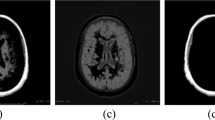Abstract
Segmentation of regions of interest plays important role in computer aided brain medical image diagnosis. Fuzzy techniques are widely used for this purpose as they can handle with imprecise or vague image information. The major achievement of this research is the introduction of a new region growing segmentation technique for which any fuzzy control model is possible to be applied. This enables the combination of physician knowledge, easily represented by fuzzy rules and therefore generalized, with the main concept of fuzzy control. Our approach is capable to segment cerebrospinal fluid in the cortical and subcortical areas of the brain. The study was performed by applying the segmentation method proposed on a dataset of 228 computed tomography scans of patients with diagnosed Alzheimer disease.
Access this chapter
Tax calculation will be finalised at checkout
Purchases are for personal use only
Similar content being viewed by others
References
Aparajeeta, J., et al.: Modified possibilistic fuzzy C-means algorithms for segmentation of magnetic resonance image. Appl. Soft Comput. 41, 104–119 (2016)
Al-Ayyoub, M., et al.: A GPU-based implementations of the fuzzy C-means algorithms for medical image segmentation. J. Supercomput. 71(8), 3149–3162 (2015)
Baâzaoui, A., et al.: Semi-automated segmentation of single and multiple tumors in liver CT images using entropy-based fuzzy region growing. IRBM 38, 98–108 (2017)
Chaibou M., et al.: A combined approach based on fuzzy classification and contextual region growing to image segmentation. In: 13th International Conference on Computer Graphics, Imaging and Visualization (CGiV) (2016)
Dhage P., et al.: Watershed segmentation brain tumor detection. In: International Conference on Pervasive Computing (ICPC) (2015)
Elazab, A., et al.: Segmentation of brain tissues from magnetic resonance images using adaptively regularized kernel-based fuzzy c-means clustering. Comput. Math. Methods Med. 5, 1–12 (2015)
Karnik, N.N., et al.: Type-2 fuzzy logic systems. IEEE Trans. Fuzzy Syst. 7(6), 643–658 (1999)
Karnik, N.N., et al.: Centroid of a type-2 fuzzy set. Inf. Sci. 132, 195–220 (2001)
Kerkeni, A., et al.: A coronary artery segmentation method based on multiscale analysis and region growing. Comput. Med. Imaging Graph. 48, 49–61 (2016)
Lefranc, S., et al.: Groupwise connectivity-based parcellation of the whole human cortical surface using watershed-driven dimension reduction. Med. Image Anal. 30, 11–29 (2016)
Mendel, J.M.: Uncertain Rule-Based Fuzzy Logic Systems: Introduction and New Directions. Prentice-Hall, Upper Saddle River (2001)
Mendel, J.M., John, R.I.: Type-2 fuzzy sets made simple. IEEE Trans. Fuzzy Syst. 10(2), 117–127 (2002)
Mohammed, M.A., et al.: Automatic segmentation and automatic seed point selection of nasopharyngeal carcinoma from microscopy images using region growing based approach. J. Comput. Sci. 20, 61–69 (2017)
Tan, Sh., et al.: Adaptive region-growing with maximum curvature strategy for tumor segmentation in F-FDG PET. Phys. Med. Biol. 62(13), 5383–5402 (2017)
Verma, H., et al.: An improved intuitionistic fuzzy c-means clustering algorithm incorporating local information for brain image segmentation. Appl. Soft Comput. 46, 543–557 (2016)
Wu, D., Mendel, J.M.: Enhanced Karnik-Mendel algorithms. IEEE Trans. Fuzzy Syst. 17(4), 923–934 (2009)
Wu, D., Nie, M.: Comparison and practical implementation of type reduction algorithms for type-2 fuzzy sets and systems. In: Proceedings of the IEEE International Conference on Fuzzy Systems, Taipei, Taiwan, June 2011, pp. 2131–2138 (2011)
Wu, D.: On the fundamental differences between interval type-2 and type-1 fuzzy logic controllers. IEEE Trans. Fuzzy Syst. 20(5), 832–848 (2012)
Author information
Authors and Affiliations
Corresponding author
Editor information
Editors and Affiliations
Rights and permissions
Copyright information
© 2020 Springer Nature Switzerland AG
About this paper
Cite this paper
Tabakov, M., Jablonski, B. (2020). A New Region Growing Medical Image Segmentation Algorithm Based on Interval Type-2 Fuzzy Sets. In: Barolli, L., Amato, F., Moscato, F., Enokido, T., Takizawa, M. (eds) Web, Artificial Intelligence and Network Applications. WAINA 2020. Advances in Intelligent Systems and Computing, vol 1150. Springer, Cham. https://doi.org/10.1007/978-3-030-44038-1_121
Download citation
DOI: https://doi.org/10.1007/978-3-030-44038-1_121
Published:
Publisher Name: Springer, Cham
Print ISBN: 978-3-030-44037-4
Online ISBN: 978-3-030-44038-1
eBook Packages: Intelligent Technologies and RoboticsIntelligent Technologies and Robotics (R0)




